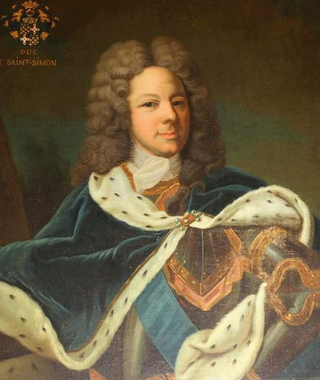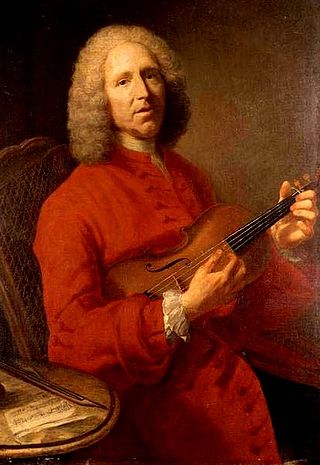
Marie Antoinette was the last Queen of France prior to the French Revolution and the establishment of the French First Republic. Marie Antoinette was the wife of Louis XVI. Born Archduchess Maria Antonia of Austria, she was the penultimate child and youngest daughter of Empress Maria Theresa and Emperor Francis I. She married Louis Auguste, Dauphin of France, in May 1770 at the age of 14. She then became the Dauphine of France. On 10 May 1774, her husband ascended the throne as Louis XVI and she became queen.

The Palace of Versailles is a former royal residence commissioned by King Louis XIV located in Versailles, about 18 kilometres (11 mi) west of Paris, in the Yvelines Department of Île-de-France region in France.

Louis XVIII, known as the Desired, was King of France from 1814 to 1824, except for a brief interruption during the Hundred Days in 1815. Before his reign, he spent 23 years in exile from France beginning in 1791, during the French Revolution and the First French Empire.

Louis de Rouvroy, duc de Saint-Simon, GE, was a French soldier, diplomat, and memoirist. He was born in Paris at the Hôtel Selvois, 6 rue Taranne. The family's ducal peerage (duché-pairie), granted in 1635 to his father Claude de Rouvroy (1608–1693), served as both perspective and theme in Saint-Simon's life and writings. He was the second and last Duke of Saint-Simon.

Claude de Rouvroy, 1st Duke of Saint-Simon, was a French soldier and courtier, and favourite of Louis XIII of France, who created his dukedom for him. His only son Louis de Rouvroy, Duke of Saint-Simon (1675–1755) was the famous memoirist of the court of Louis XIV.

Armand Emmanuel Sophie Septimanie de Vignerot du Plessis, 5th Duke of Richelieu and Fronsac, was a French statesman during the Bourbon Restoration. He was known by the courtesy title of Count of Chinon until 1788, then Duke of Fronsac until 1791, when he succeeded his father as Duke of Richelieu.
A New Year's levée is a social event on New Year's Day hosted by the Governor General of Canada, the lieutenant governors, military establishments, municipalities, and other institutions.

A baldachin, or baldaquin, is a canopy of state typically placed over an altar or throne. It had its beginnings as a cloth canopy, but in other cases it is a sturdy, permanent architectural feature, particularly over high altars in cathedrals, where such a structure is more correctly called a ciborium when it is sufficiently architectural in form. Baldachins are often supported on columns, especially when they are disconnected from an enclosing wall.

Paul de Beauvilliers, count and later (1679) 2nd duc de Saint-Aignan (1648–1714), often referred to as the duc de Beauvilliers, was a French government official under King Louis XIV.

Les surprises de l'Amour is an opéra-ballet in two entrées and a prologue by the French composer Jean-Philippe Rameau. It was first performed in Versailles on 27 November 1748. The opera is set to a libretto by Gentil-Bernard. According to the usage of the time, it was originally just billed as a ballet and was only later classified by scholars as an opéra-ballet, although its content might more precisely ascribe it to the ballet héroïque genre.
La Chambre du Roi, "the king's bedchamber"), has always been the central feature of the king's apartment in traditional French palace design Ceremonies surrounding the daily life of the king — such as the levée and the coucher — were conducted in the bedchamber.

Valet de chambre, or varlet de chambre, was a court appointment introduced in the late Middle Ages, common from the 14th century onwards. Royal households had many persons appointed at any time. While some valets simply waited on the patron, or looked after his clothes and other personal needs, itself potentially a powerful and lucrative position, others had more specialized functions. At the most prestigious level it could be akin to a monarch or ruler's personal secretary, as was the case of Anne de Montmorency at the court of Francis I of France. For noblemen pursuing a career as courtiers, like Étienne de Vesc, it was a common early step on the ladder to higher offices.
The Menus-Plaisirs du Roi was, in the organisation of the French royal household under the Ancien Régime, the department of the Maison du Roi responsible for the "lesser pleasures of the King", which meant in practice that it was in charge of all the preparations for ceremonies, events and festivities, down to the last detail of design and order.

René de Longueil, marquis (1658) de Maisons (1596–1677), le président de Maisons, was Surintendant des Finances under Louis XIV. He built the Château de Maisons.

The Cat and the King (1981) is a work of historical fiction about the court of French King Louis XIV (1638–1715) by novelist Louis Auchincloss. The novel's narrator—Louis de Rouvroy, the second Duc de Saint-Simon—was a real-life French noble who observed life at the court and recorded in his memoirs all that he saw and felt about the reign of the Sun King. Saint-Simon (1675–1755) is mentioned in many of Auchincloss’ works and in The Cat and the King he fantasizes that the Duc kept on writing after his real-life memoirs were published.

Alexandre Bontemps was the valet of King Louis XIV and a powerful figure at the court of Versailles, respected and feared for his exceptional access to the King. He was the second of a sequence of five Bontemps to hold the position of Premier valet de la Chambre du Roi in uninterrupted succession between 1643 and 1766, when an early death, leaving no successor, broke the line. There were four head or Premier valets de chambre, of whom Bontemps became the most senior in 1665, and thirty-two valets.

The appartement du roi or King's Apartment is the suite of rooms in the Palace of Versailles that served as the living quarters of Louis XIV. Overlooking the Marble Court, these rooms are situated in the oldest part of the chateau in rooms originally designated for use by the queen in Louis XIII's chateau. Owing largely to the discomfort of the grand appartement du roi and to the construction of the Hall of Mirrors, Louis XIV began to remodel these rooms for his use shortly after the death of Maria Theresa in 1684. The appartement du roi evolved to become the everyday working quarters for Louis XV and Louis XVI.

Les Élémens, or Ballet des élémens, is an opéra-ballet by the French composers André Cardinal Destouches and Michel Richard Delalande. It has a prologue and four entrées. The libretto was written by Pierre-Charles Roy. It was styled "the third ballet danced by the king" because the 11-year-old Louis XV performed dance divertissements in it, as he had already done in the previous ballets, L'inconnu by various authors, and Les folies de Cardenio by Delalande, both staged at court in 1720.

The Palace of Versailles is a royal château in Versailles, Yvelines, in the Île-de-France region of France. When the château was built, Versailles was a country village; today, however, it is a suburb of Paris, some 20 kilometres southwest of the French capital. The court of Versailles was the centre of political power in France from 1682, when Louis XIV moved from Paris, until the royal family was forced to return to the capital in October 1789 after the beginning of the French Revolution. Versailles is therefore famous not only as a building, but as well as a symbol of the system of absolute monarchy of the Ancien Régime.

Charles Olivier de Saint-Georges, 4th Marquis of Vérac was a French military officer and diplomat of the French Ancien Régime.




















